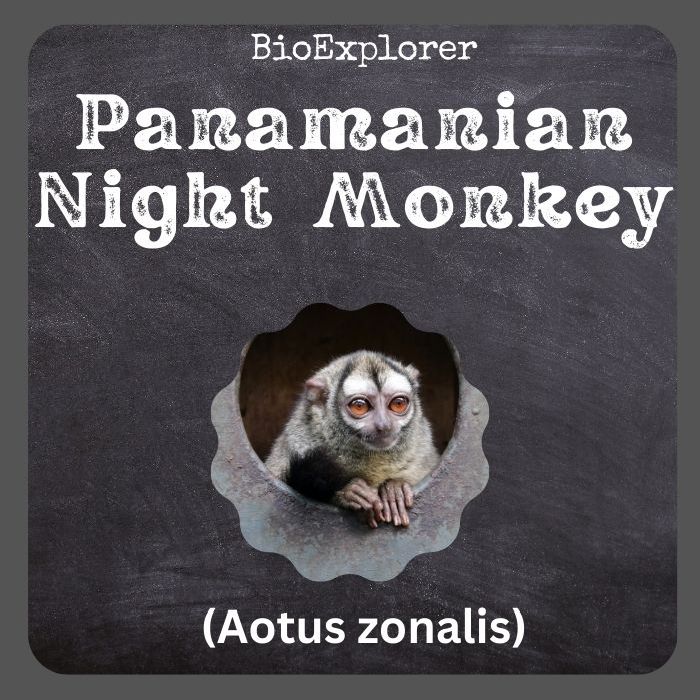
| Animalia | Primates | Aotidae | Aotus | Aotus zonalis |

- Common Name: Panamanian Night Monkey
- Taxonomy Classification Year: 1914
- Monkey Size: 30.5 to 33 cm (12 to 13 in)
- Skin Color(s): Gray-brown to reddish-brown
- Habitat: Forest, rainforest
- Diet: Omnivorous
- Native Countries: Panama, Colombia
Panamanian Night Monkey Distribution
Panamanian Night Monkey Characteristics
The Panamanian night monkey[1] or Chocoan night monkey (Aotus zonalis) is a species of night monkey formerly considered a subspecies of the grey-bellied night monkey in the Aotidae family.
- The distribution area includes Panama and the Colombian region of Chocó. The Panamanian night monkey has large brown eyes, which, unlike many nocturnal animals, lack a tapetum lucidum.
- The tapetum lucidum is a layer of tissue in the eye that sits behind the retina, reflects light through the retina, and helps with night vision.
- This gives nocturnal animals the typical “eye glow” that nocturnal monkeys lack. In addition, although aotus means “earless“, night monkeys have tiny, hard-to-see ears surrounded by tufts of fur.
- Its hair is grey-brown to reddish brown with yellowish hairs on its abdomen.
- The backs of the hands and feet have dark brown or black hairs. The thickness and length of their fur depending on the altitude at which they live.
- Those that live at higher elevations have thicker, shaggy coats than those that live at sea level. Unique facial markings, including the Panamanian night monkey, are common among night monkeys.
- Black stripes are found starting at the crown of the head on both sides of the face and down the bridge of the nose. They have long, slender fingers and large digital pads on their hands and feet.
What Do Panamanian Night Monkeys Eat?
In the wild, the Panamanian Night Monkey consumes these organic matters but not limited to[¶]:
- Guabo Pachón (Inga goldmanii).
- Breadnut (Brosimum alicastrum)
- Angelica Tree (Dendropanax arboreus).
- Hogplum (Spondias mombin)
- Icecreambean (Inga edulis)
- Guarumo (Cecropia obtusifolia)
- Chirimoya (Annona spraguei)
- Star Apple (Chrysophyllum cainito).
- Abas (Psidium guajava)
- Smooth Manjack (Cordia laevigata).
- False Coffee (Faramea occidentalis).
- Amate (Ficus obtusifolia)
- Requia Colorada (Trichilia cipo).
- Malaysian Apple (Syzygium malaccense).
- Jagua (Genipa americana)
- Mango (Mangifera indica)
- Guarumo (Cecropia longipes)
- Pachiuba (Socratea exorrhiza)
- Conejo (Protium tenuifolium)
- Panama Hat Plant (Carludovica palmata).
- Panama Tree (Sterculia apetala).
Panamanian Night Monkey Facts
- Panamanian night monkeys are sympatric with other species. They do not compete for resources with other animals in their range due to their alternate schedules.
- These night monkeys, like most monkeys, are endothermic, meaning they can generate their own heat.
- Panamanian night monkeys are monochromatic; they only see the world in shades of gray.
- The species benefit from a nocturnal lifestyle, as a nocturnal activity provides some protection from the daytime heat, predators, and difficulties in thermoregulation.
- Moonlight is vital for Panamanian night monkeys. When the moon is bright, they travel farther than when the night sky is dark and gray. Also, of course, the bright light of the moon makes it easier for them to see.
Suggested Reading: All Types of Monkeys
Cite This Page
APA7MLA8Chicago
BioExplorer.net. (2025, November 07). Panamanian Night Monkey. Bio Explorer. https://www.bioexplorer.net/animals/mammals/monkeys/panamanian-night-monkey/.
BioExplorer.net. "Panamanian Night Monkey" Bio Explorer, 07 November 2025, https://www.bioexplorer.net/animals/mammals/monkeys/panamanian-night-monkey/.
BioExplorer.net. "Panamanian Night Monkey" Bio Explorer, November 07 2025. https://www.bioexplorer.net/animals/mammals/monkeys/panamanian-night-monkey/.











